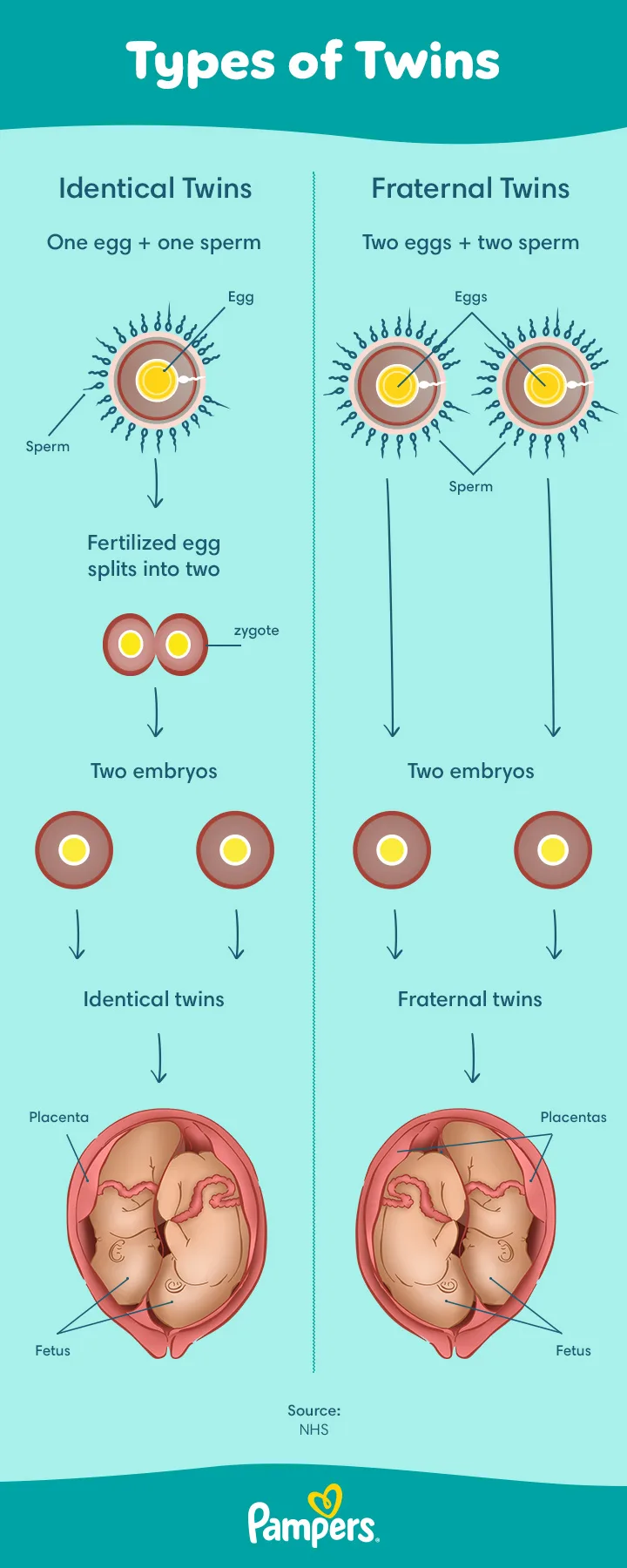
What Are the Different Types of Twins?
It’s exciting finding out that you’re a mum-to-be, but what if it turns out you’re expecting not one, but two babies? Having twins can mean double the joy, but you’ve probably got twice as many questions too! Read on to learn about the differences between identical and fraternal twins, and what the other differences are between the common types of twin pregnancy.
Fraternal Twins (Dizygotic)
Fraternal twins, which are also called dizygotic or non-identical twins, are the result of two separate eggs being fertilised by two separate sperm. This can happen because the ovaries occasionally release not one, but two eggs in the same menstrual cycle – if both are fertilised, it can lead to a twin pregnancy. Fraternal twins can be the same sex (two boys or two girls) or different (one girl and one boy). Each foetus is nourished by its own placenta and protected by a separate amniotic sac. Fraternal twins are as alike as any siblings from two separate pregnancies. They share the same amount of genetic material as any two brothers, sisters or a brother and sister. Fraternal twins are the most common type of twins, accounting for around two thirds of all twin pregnancies.
Identical Twins (Monozygotic)
Identical twins, also known as monozygotic twins, form when a single fertilised egg splits into two and grows into two separate embryos. The twins are the same gender, have the same blood type and share physical traits such as eye colour, hair colour and facial features.
Identical twins may or may not share a placenta and/or amniotic sac. This is where things get a little bit more complicated, but don’t worry – the general principles aren’t that difficult to understand. We’ll explain this side of things in more detail a little further down.
Identical twins are less common than fraternal twins – around one third of all twins are identical. If you’re pregnant, your overall chance of having identical twins is about 1 in 250. It’s not always possible to tell if you have identical or fraternal twins while you’re pregnant, although sometimes an ultrasound scan showing the placenta (or placentas) – if it’s performed before 14 weeks pregnant – can offer a strong clue. The most accurate way of determining whether your twins are identical or fraternal is a DNA test, which can be performed after your babies are born. Of course, you might decide this isn’t necessary if your newborn twins look very different from each other.
Conjoined Twins
In rare cases the embryo only partially separates, and two identical twin foetuses remain partially connected as they grow. Conjoined twins are extremely rare. Sadly, many conjoined twins do not make it to full term or live only a short while after birth. Conjoined twins who do survive are sometimes successfully separated by surgery.
The Different Types of Twin Pregnancy
Whether twins are identical or not is only one of the differences between the types of twin pregnancy. Other distinctions are made based on whether the twins share a placenta and/or the membranes of the amniotic sac.
These differences are important because each type has different risks, which need to be managed by your midwife or doctor to ensure the safest possibly pregnancy for you and your little ones. To understand the three main types of twin pregnancy, it helps to know that the sac of fluid surrounding and protecting a foetus is made up of two membranes:
Both membranes are often referred to together as the ‘amniotic sac’ or simply the ‘membranes’. However, when talking about the different kinds of twin pregnancy you might also hear the inner membrane by itself called the amniotic sac – as distinct from the outer membrane, the chorion. So, for example, if your midwife or doctor says that your twins share a placenta and chorion but have their own amniotic sacs, it means they share the outer membrane but not the inner one. This may seem a little complicated, but although there are a few other factors that can vary, broadly speaking, twin pregnancies fall into three main categories. The three main types of twin pregnancy are:
Dichorionic Diamniotic (DCDA) Twins
This is where each twin has a separate chorion, amnion and placenta. All fraternal twins and around a third of all identical twins are this type. This is the most common type of twin pregnancy, and it also carries the lowest risks. You’ll still be monitored more closely than a single pregnancy though, and it’s important to attend all your antenatal appointments and scans so any problems can be spotted and treated in good time if necessary.
Monochorionic Diamniotic (MCDA) Twins
These types of twins are enclosed in a single chorion and share the same placenta, but each is snugly housed in a separate amnion (the inner membrane). Around two thirds of identical twins are this type. Because of the shared placenta, the risks of this type of twin pregnancy are a little higher, so you’ll likely be offered more frequent scans and monitored more closely. You may also be referred to a specialist clinic.
Monochorionic Monoamniotic Twins
These types of twins share the same chorion, placenta and amnion. This is the rarest type of twin pregnancy – only affecting 1 in every 100 sets of identical twins – and it comes with a higher risk of complications because the foetuses can get tangled in their umbilical cords. If you are pregnant with monochorionic-monoamniotic twins, your pregnancy will be monitored closely. It’s also likely that you’ll be offered a planned birth earlier than you would in the case of DCDA or MCDA twins.
How Common Is Having Twins?
Multiple births – which include twins, triplets, quadruplets and more – have become more common in recent years, partly because more couples are using fertility treatments. Another factor is that on average mums-to-be are becoming pregnant later, which can also increase the likelihood of a multiple birth. Today in the UK around 1 in every 65 births are twins or other multiples, compared to 1 in every 100 births in 1984.
FAQS AT A GLANCE
Fraternal twins, also called non-identical twins, are the most common type of twins – two thirds of all twins are non-identical.
The Bottom Line
It isn’t always easy to understand the biology behind twins, but whatever kind of twins or multiples you have they’re sure to be a miracle of nature. In the meantime, if you thought choosing one baby name was going to be tricky, now you’ve got to come up with two! Check out our list of 100+ twin baby names for some inspiration.
The information in this article is based on the expert advice found in trusted medical and government sources, such as the National Health Service (NHS). You can find a full list of sources used for this article below. The content on this page should not replace professional medical advice. Always consult medical professionals for full diagnosis and treatment.
- NHS: Pregnant with twins
- NHS: Periods and fertility in the menstrual cycle
- NHS: Antenatal care with twins
- NHS: Multiple pregnancy
- NHS: You are having twins or triplets
- NHS: Second set of rare conjoined twins separated at Great Ormond Street Hospital in less than 12 months
- NHS: When your waters break early
- NHS: Multiple Pregnancy – Patient Information Leaflet
Read more about Pregnancy
Join Pampers Club and get:






